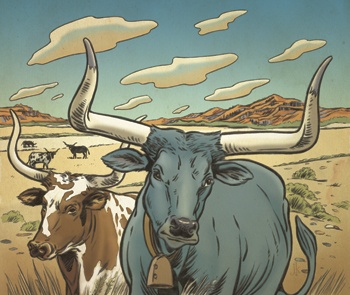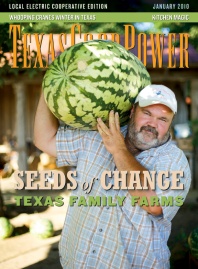During the Civil War, while Texas boys were away from home fighting in the Confederate Army, there weren’t many cowboys around to tend the longhorn cattle abandoned on ranches and farms throughout the state. The longhorns, perfectly happy with this arrangement, returned to their wild ways and multiplied. By the time the soldiers got back home, Texas was teeming with wild cattle.
Most had no brand and little value. A scrawny longhorn might bring a dollar or two in Texas. However, cattle were worth $40 a head in the market towns of the beef-starved north. The era of long cattle drives was about to get under way.
Driving herds of wild longhorns a thousand miles was tricky business. Freshly separated from thorny mesquite thickets, the cattle were bent on returning home. Few of them wanted to set out on what would become a four- or five-month hike up routes that included the Great Western Cattle Trail or the Chisholm Trail. Keeping them headed in the right direction tested the mettle of cowboy and cow pony alike, until some deep-thinking drover came up with the concept of using a lead steer.
Lead steers were born with a certain bossy mentality. They wanted to go first. The most famous of these was Charles Goodnight’s Old Blue. Like some drivers you encounter on modern highways, Old Blue couldn’t stand the sight of something in front of him. He passed all the other steers until he got into the lead. A tall, gunmetal-blue steer (the cowboys called his color “mulberry”) with horns that spread wide, Old Blue commanded the point position on eight trips from the Palo Duro Canyon, where Goodnight’s famous JA Ranch was located, to Dodge City, Kansas.
When Goodnight bought Old Blue as a 4-year-old, one of a group of 5,000, the young steer already showed signs of natural leadership. He seemed to have a steady quality that calmed the other flighty longhorns. Early on, Goodnight noticed that cattle, after bedding down for the night, took up the same position in the herd the next morning that they had occupied the day before. Taking advantage of this insight, Goodnight hung a bell around Old Blue’s neck. Before long, the rest of the herd grew accustomed to following the sound of the bell as it led them up the Great Western Cattle Trail.
When it was time to bed the herd down each night, the clapper on Old Blue’s bell was tied up. Choosing not to sleep among the masses, Blue made his way to the campfire where, as legend has it, he feasted on cornbread, biscuits and dried apples given to him by the appreciative cowboys. They knew the value of a good lead steer. At river crossings, Old Blue chose the best place to take the herd across and stepped smartly out into the water, never giving the herd a chance to mill around and decide they didn’t want to get wet.
When the cattle finally reached their destination, he led the way into the pen and then stepped aside while the other steers entered. When the last trailing steer was inside the gate, Blue rushed back out. The big, blue steer was far too valuable to send to slaughter.
For eight years, Old Blue led cattle to market, an estimated 10,000 head. During the first few days of each trip, his patient presence and reassuring bawl soothed the skittish steers, which were always searching for a reason to stage a stampede. The snap of a twig, the yip of a coyote, any excuse would start them on a headlong run. Not only did the cattle run off lots of weight, but many were injured or killed in the panicked charges, along with an occasional cowboy. Old Blue refused to participate in these shenanigans. When the cattle tired, the seasoned steer would return to his place at the point and lead the panting animals north again. After Blue’s eighth and final trip up the trail, he retired in comfort to a grassy pasture on the JA Ranch, where he lived to be 20. Upon his death, Blue’s massive horns were mounted in the headquarters of Goodnight’s ranch, but today they are on display at the Panhandle-Plains Historical Museum in Canyon.
——————–
Martha Deeringer regularly writes history pieces for Texas Co-op Power.


